Output of Volcanic SO2 Gases and Their Dispersion in the Atmosphere: The Case of Vulcano Island, Aeolian Archipelago, Italy
Abstract
1. Introduction
2. Materials and Methods
2.1. Vulcano SO2 Network
2.2. Air Dispersion Model
2.3. Measurements of SO2 Concentrations in Air
2.4. Environmental Parameters Network and 2008_2024 Dataset
3. Results
3.1. Near Real-Time Monitoring of SO2 Solfataric Clouds (2008–2024)
3.2. SO2 Dispersion Maps
3.2.1. SO2 Degassing Unrest (2009)
3.2.2. SO2 Normal Degassing (2010–2021)
3.2.3. SO2 Degassing Unrest (2021)
3.2.4. SO2 Degassing Unrest (2024)
3.3. SO2 Concentrations in the Air
4. Discussion
5. Conclusions
Author Contributions
Funding
Institutional Review Board Statement
Informed Consent Statement
Data Availability Statement
Acknowledgments
Conflicts of Interest
References
- Pyle, D.M.; Beattie, P.D.; Bluth, G.J.S. Sulphur emissions to the stratosphere from explosive volcanic eruptions. Bull. Volcanol. 1996, 57, 663–671. [Google Scholar] [CrossRef]
- Fioletov, V.E.; McLinden, C.A.; Griffin, D.; Abboud, I.; Krotkov, N.; Leonard, P.J.T.; Li, C.; Joiner, J.; Theys, N.; Carn, S. Version 2 of the global catalogue of large anthropogenic and volcanic SO2 sources and emissions derived from satellite measurements. Earth Syst. Sci. Data 2023, 15, 75–93. [Google Scholar] [CrossRef]
- Carn, S.A.; Fioletov, V.E.; McLinden, C.A.; Li, C.; Krotkov, N.A. A decade of global volcanic SO2 emissions measured from space. Sci. Rep. 2017, 7, 44095. [Google Scholar] [CrossRef] [PubMed]
- Arthur, M.A. Volcanic contributions to the carbonand sulfur geochemical cycles and global change. In Encyclopedia of Volcanoes; Sigurdsson, H., Houghton, B., Rymer, H., Stix, J., McNutt, S., Eds.; Academic Press: San Diego, CA, USA, 2000; pp. 1045–1056. [Google Scholar]
- Brantley, S.L.; Koepenick, K.W. Measured carbon dioxide emissions from Oldoinyo Lengai and the skewed distribution of passive volcanic fluxes. Geology 1995, 23, 933–936. [Google Scholar] [CrossRef]
- WHO. Air quality guidelines for Europe. In World Health Organization, Regional Publication, 2nd ed.; European Series, N; WHO: Geneva, Switzerland, 2000; Volume 91. [Google Scholar]
- EU. Council Directive 1999/30/EC of 22 April 1999 relating to limit values for sulphur dioxide, nitrogen dioxide and oxides of nitrogen, particulate matter and lead in ambient air. Eur. Union Off. J. 1999, L163, 41–60. [Google Scholar]
- Hansell, A.; Oppenheimer, C. Health hazards from volcanic gases: A systematic literature review. Arch. Environ. Health 2010, 59, 628–639. [Google Scholar] [CrossRef]
- Robock, A. Volcanic eruptions and climate. Rev. Geophys. 2000, 38, 191–219. [Google Scholar] [CrossRef]
- Stevenson, D.S.; Johnson, C.E.; Collins, W.J.; Derwent, R.G. The Tropospheric Sulphur Cycle and the Role of Volcanic SO2; Special Publications; Geological Society: London, UK, 2007; Volume 213, p. 295. [Google Scholar]
- Longo, K.M.; Freitas, S.R.; Pirre, M.; Marécal, V.; Rodrigues, L.F.; Panetta, J.; Arteta, J. The chemistry CATT-BRAMS model (CCATT-BRAMS 4.5): A regional atmospheric model system for integrated air quality and weather forecasting and research. Geosci. Model Dev. 2010, 3, 585–601. [Google Scholar] [CrossRef]
- Pope, C.A.; Dockery, D.W. Health effects of fine particulate air pollution: Lines that connect. J. Air Waste Manag. Assoc. 2006, 56, 709–742. [Google Scholar] [CrossRef]
- Inguaggiato, S.; Mazot, A.; Diliberto, I.S.; Inguaggiato, C.; Madonia, P.; Rouwet, D.; Vita, F. Total CO2 output from Vulcano island (Aeolian Islands, Italy). Geochem. Geophys. Geosystems 2012, 13, 1–19. [Google Scholar] [CrossRef]
- Inguaggiato, S.; Liotta, M.; Rouwet, D.; Tassi, F.; Vita, F.; Schiavo, B.; Keller, N.S. Sulfur origin and flux variations in fumarolic fluids of Vulcano Island, Italy. Front. Earth Sci. 2023, 11, 1197796. [Google Scholar] [CrossRef]
- Aiuppa, A.; Bitetto, M.; Calabrese, S.; Donne, D.D.; Lages, J.; La Monica, F.P.; Chiodini, G.; Tamburello, G.; Cotterill, A.; Fulignati, P.; et al. Mafic magma feeds degassing unrest at Vulcano Island, Italy. Commun. Earth Environ. 2022, 3, 255. [Google Scholar] [CrossRef]
- Federico, C.; Cocina, O.; Gambino, S.; Paonita, A.; Branca, S.; Coltelli, M.; Sortino, F. Inferences on the 2021 ongoing volcanic unrest at Vulcano Island (Italy) through a comprehensive multidisciplinary surveillance network. Remote Sens. 2023, 15, 1405. [Google Scholar] [CrossRef]
- Capecchiacci, F.; Tassi, F.; Vaselli, O.; Venturi, S. The 2021–2023 unrest of Vulcano Island volcanic system (Aeolian Islands, Italy): Geochemical evidence from fumarolic gas discharges and well waters. Bull. Volcanol. 2025, 87, 24. [Google Scholar] [CrossRef]
- Inguaggiato, S.; Vita, F.; Diliberto, I.S.; Mazot, A.; Calderone, L.; Mastrolia, A.; Corrao, M. The Extensive Parameters as a Tool to Monitoring the Volcanic Activity: The Case Study of Vulcano Island (Italy). Remote Sens. 2022, 14, 1283. [Google Scholar] [CrossRef]
- Diliberto, I.S. Long-term monitoring on a closed-conduit volcano: A 25 year long time-series of temperatures recorded at La Fossa cone (Vulcano Island, Italy), ranging from 250 °C to 520 °C. J. Volcanol. Geotherm. Res. 2017, 346, 151–160. [Google Scholar] [CrossRef]
- Vita, F.; Schiavo, B.; Inguaggiato, C.; Inguaggiato, S.; Mazot, A. Environmental and volcanic implications of volatile output in the atmosphere of vulcano island detected using SO2 plume (2021–23). Remote Sens. 2023, 15, 3086. [Google Scholar] [CrossRef]
- Granieri, D.; Carapezza, M.L.; Barberi, F.; Ranaldi, M.; Ricci, T.; Tarchini, L. Atmospheric dispersion of natural carbon dioxide emissions on Vulcano Island, Italy. J. Geophys. Res. Solid Earth 2014, 119, 5398–5413. [Google Scholar] [CrossRef]
- Di Martino, R.M.R.; Gurrieri, S.; Camarda, M.; Capasso, G.; Prano, V. Hazardous changes in soil CO2 emissions at Vulcano, Italy, in 2021. J. Geophys. Res. Solid Earth 2022, 127, e2022JB024516. [Google Scholar] [CrossRef]
- Galle, B.; Oppenheimer, C.; Geyer, A.; McGonigle, A.; Edmonds, M.; Horrocks, L. A miniaturised ultraviolet spectrometer for remote sensing of SO2 fluxes: A new tool for volcano surveillance. J. Volcanol. Geotherm. Res. 2003, 119, 241–254. [Google Scholar] [CrossRef]
- Platt, U.; Stutz, J. Differential Optical Absorption Spectroscopy Principles and Applications, Physics of Earth and Space Environments; Springer: Berlin/Heidelberg, Germany, 2008; 597p, ISBN 978-3-540-75776-4. [Google Scholar]
- Platt, U.; Perner, D.; Pätz, H.W. Simultaneous measurement of atmospheric CH2O, O3, and NO2 by differential optical absorption. J. Geophys. Res. Ocean. 1979, 84, 6329–6335. [Google Scholar] [CrossRef]
- Stutz, J.; Platt, U. Numerical analysis and estimation of the statistical error of differential optical absorption spectroscopy measurements with least-squares methods. Appl. Opt. 1996, 35, 6041–6053. [Google Scholar] [CrossRef] [PubMed]
- Kern, C.; Detschmann, T.; Vogel, L.; Wohrbach, M.; Wagner, T.; Platt, U. Radiative transfer corrections for accurate spectroscopic measuremens of volcanic gas emissions. Bull. Volcanol. 2009, 72, 233–247. [Google Scholar] [CrossRef]
- Kern, C.; Sihler, H.; Vogel, L.; Rivera, C.; Herrera, M.; Platt, U. Halogen oxide measurements at Masaya Volcano, Nicaragua using active long path differential optical absorption spectroscopy. Bull. Volcanol. 2009, 71, 659–670. [Google Scholar] [CrossRef]
- Bobrowski, N.; Hönninger, G.; Galle, B.; Platt, U. Detection of bromine monoxide in a volcanic plume. Nature 2003, 423, 273–276. [Google Scholar] [CrossRef]
- Vita, F.; Inguaggiato, S.; Bobrowski, N.; Calderone, L.; Galle, B.; Parello, F. Continuous SO2 flux measurements for Vulcano Island, Italy. Ann. Geophys. 2012, 55, 2. [Google Scholar] [CrossRef]
- Galle, B.; Johansson, M.; Rivera, C.; Zhang, Y.; Kihlman, M.; Kern, C.; Lehmann, T.; Platt, U.; Arellano, S.; Hidalgo, S. Network for Observation of Volcanic and Atmospheric Change (NOVAC)—A global network for volcanic gas monitoring: Network layout and instrument description. J. Geophys. Res. 2010, 115, D05304. [Google Scholar] [CrossRef]
- Johansson, M.; Galle, B.; Zhang, Y.; Rivera, C.; Chen, D.; Wyser, K. The dual-beam mini-DOAS technique: Measurements of volcanic gas emission, plume height and plume speed with a single instrument. Bull. Volcanol. 2009, 71, 747–751. [Google Scholar] [CrossRef]
- Cimorelli, A.J.; Perry, S.G.; Venkatram, A.; Weil, J.C.; Paine, R.J.; Wilson, R.B.; Lee, R.F.; Peters, W.D.; Paumier, J.O. AERMOD: Description of Model Formulation; U.S. Environmental Protection Agency Report; EPA 2003 454/R,03,002d; U.S. EPA: Washington, DC, USA, 2003; 85p. Available online: https://gaftp.epa.gov/Air/aqmg/SCRAM/models/preferred/aermod/aermod_mfd_454-R-03-004.pdf (accessed on 11 February 2025).
- Jenkins, S.F.; Barsotti, S.; Hincks, T.K.; Neri, A.; Phillips, J.C.; Sparks, R.S.J.; Sheldrake, T.; Vougioukalakis, G. Rapid emergency assessment of ash and gas hazard for future eruptions at Santorini Volcano, Greece. J. Appl. Volcanol. 2015, 4, 16. [Google Scholar] [CrossRef]
- Thermo Fisher Scientific Inc. Model 450i Instruction Manual. 2007. Available online: https://assets.thermofisher.com/TFS-Assets/LSG/manuals/EPM-manual-Model%20450i.pdf (accessed on 15 January 2025).
- Finlayson-Pitts, B.J.; Pitts, J.N. Atmospheric Chemistry: Fundamentals and Experimental Techniques; Wiley-Interscience Publication: New York, NY, USA, 1986. [Google Scholar]
- Brimblecombe, P. Air Composition and Chemistry; Cambridge University Press: Cambridge, UK, 1996. [Google Scholar]
- Porter, J.N.; Horton, K.A.; Mouginis-Mark, P.J.; Lienert, B.; Sharma, S.K.; Lau, E.; Sutton, A.J.; Elias, T.; Oppenheimer, C. Sun photometer and lidar measurements of the plume from the Hawaii Kilauea volcano Pu’u O’o vent: Aerosol flux and SO2 lifetime. Geophys. Res. Lett. 2002, 29, 30-1–30-4. [Google Scholar] [CrossRef]
- Badalamenti, B.; Liotta, M.; Valenza, M. An automatic system for continuous monitoring of CO2, H2S, SO2 and meteorological parameters in the atmosphere of volcanic areas. Geochem. Trans. 2001, 2, 30. [Google Scholar] [CrossRef]
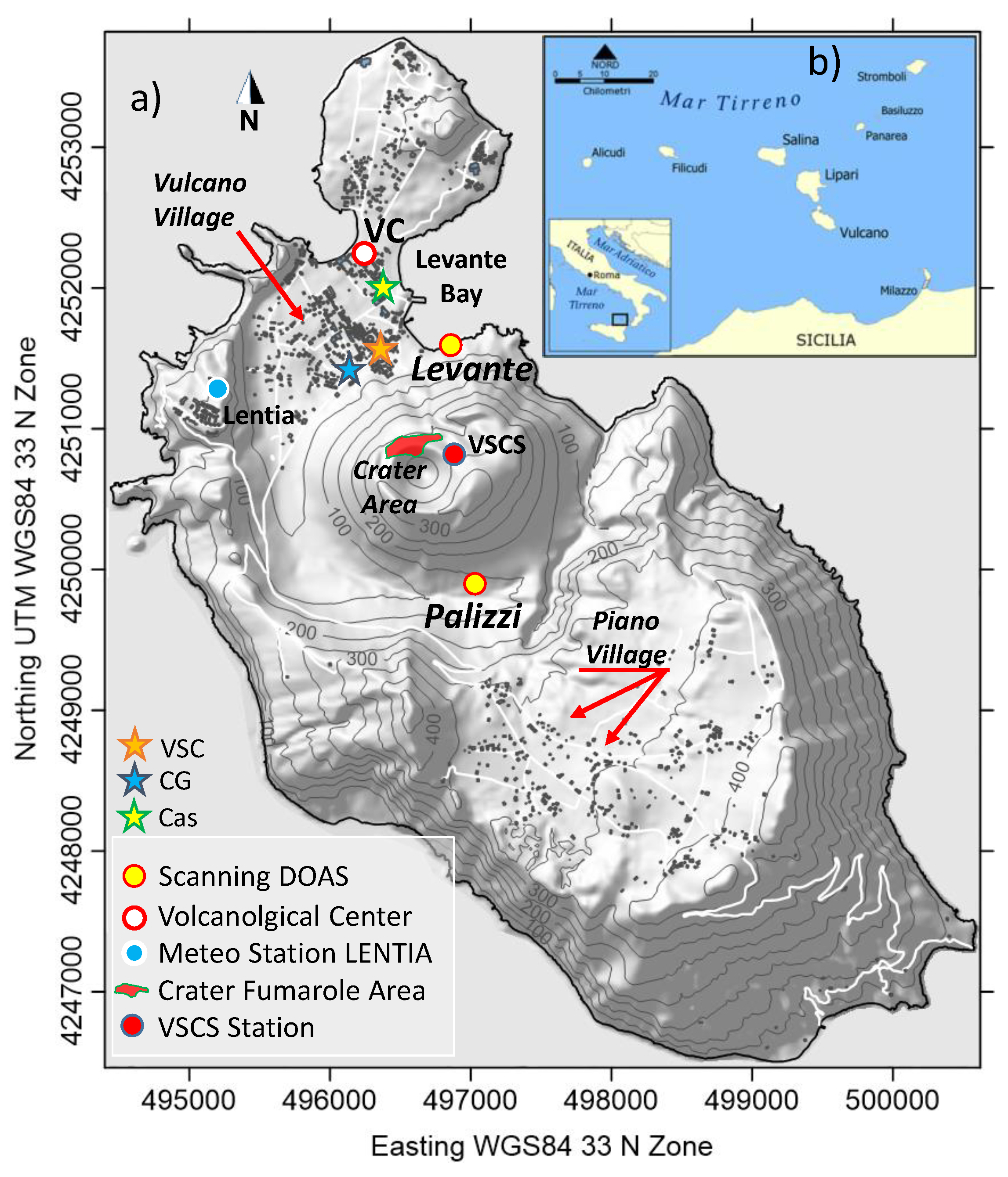

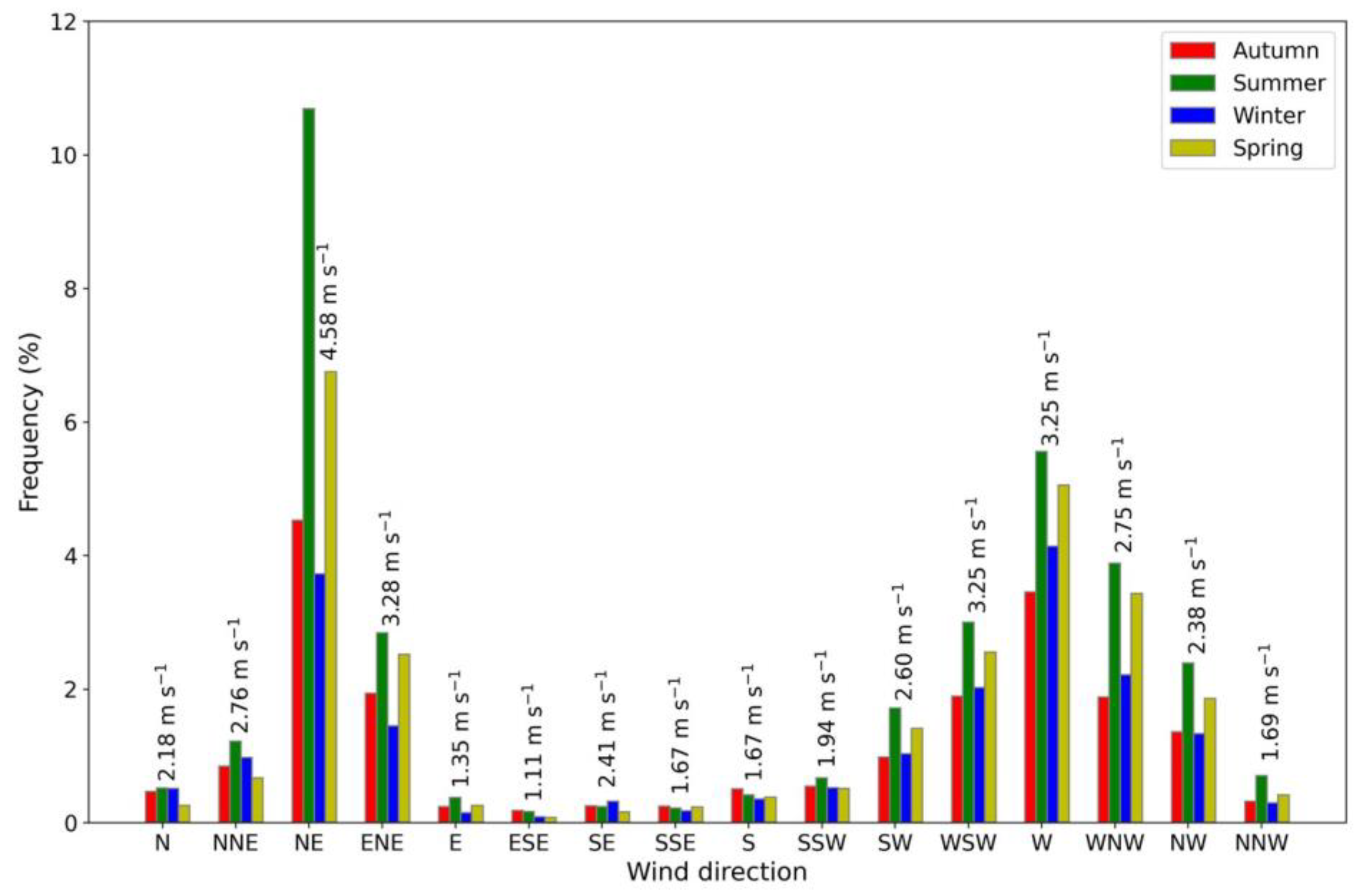



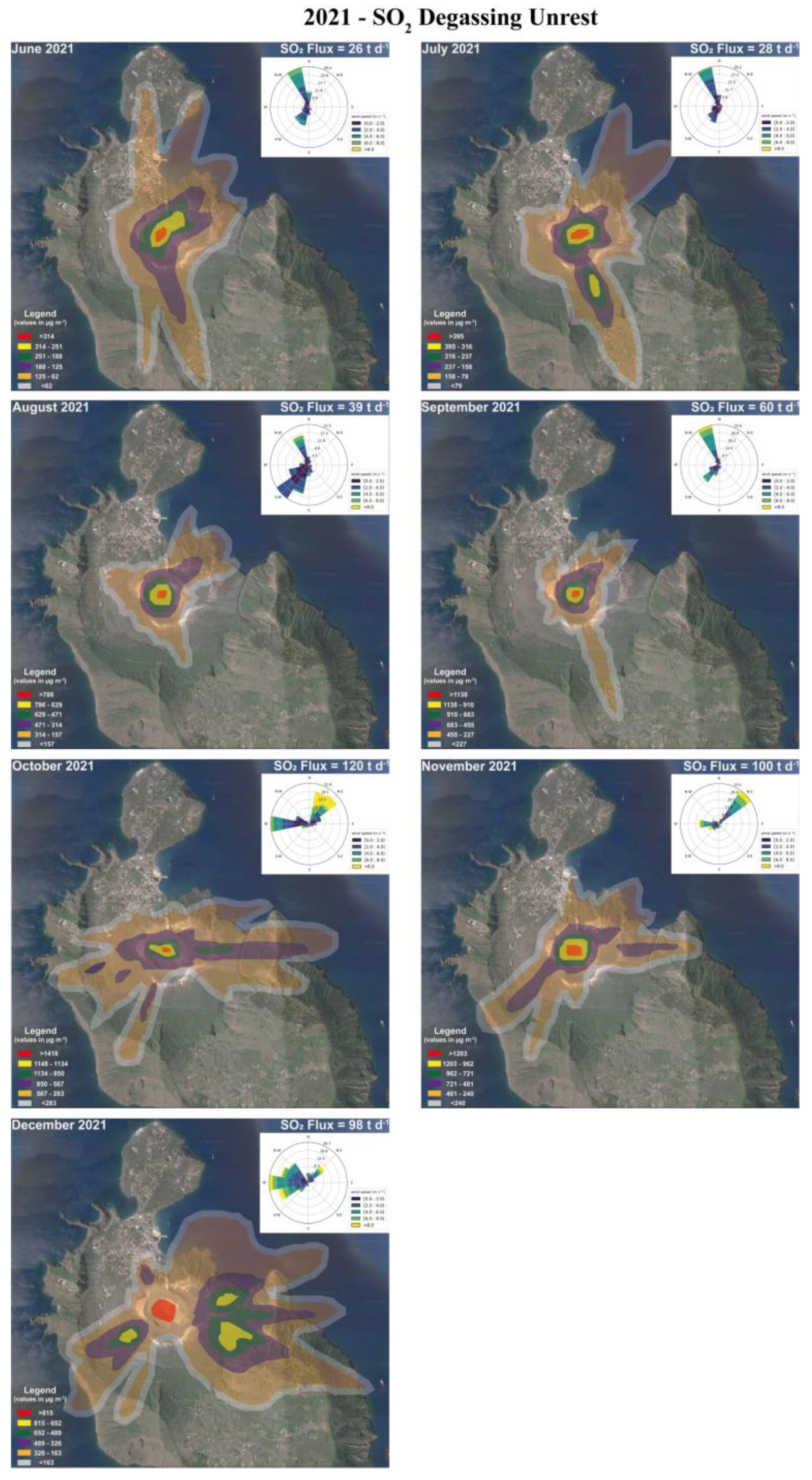
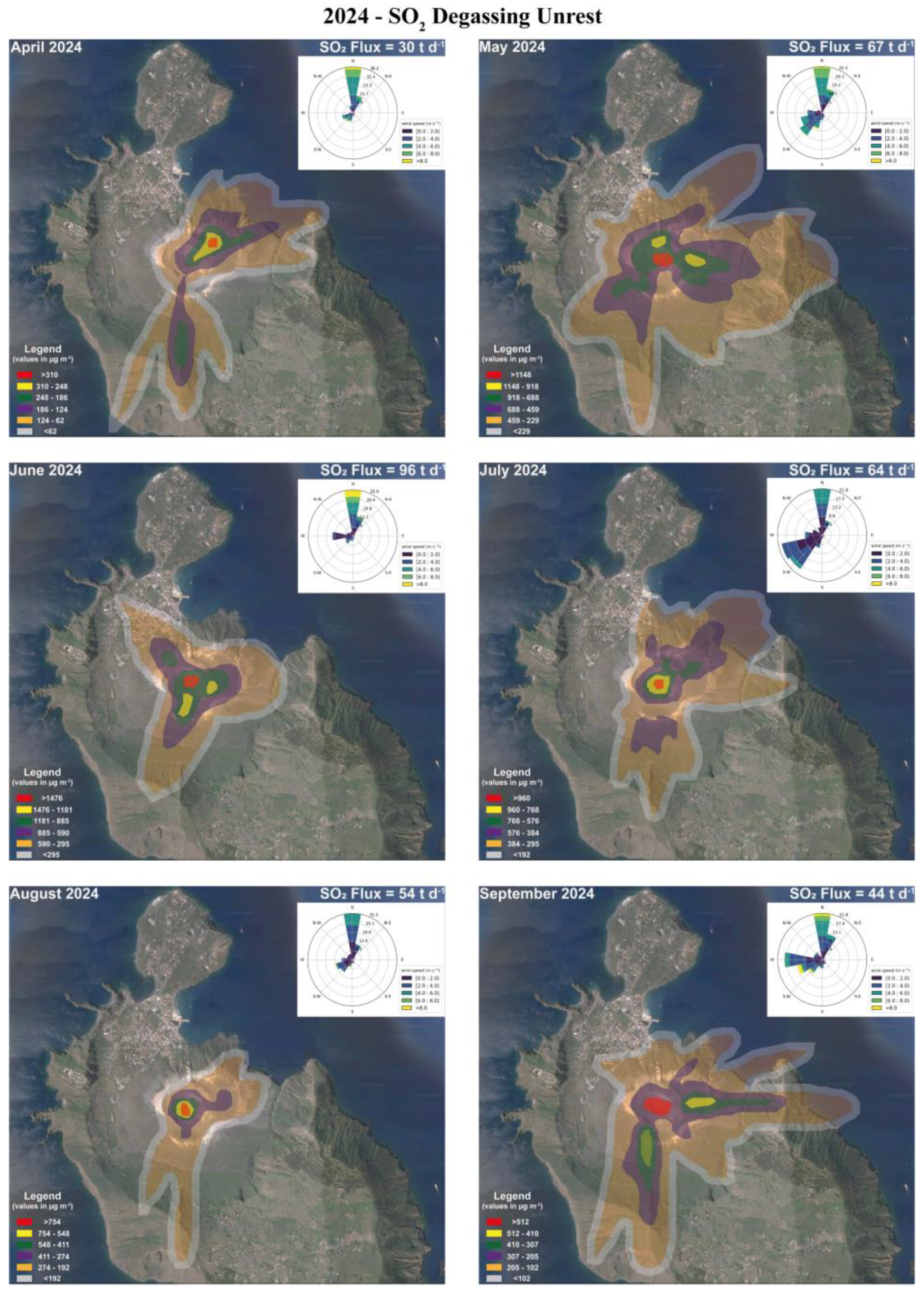
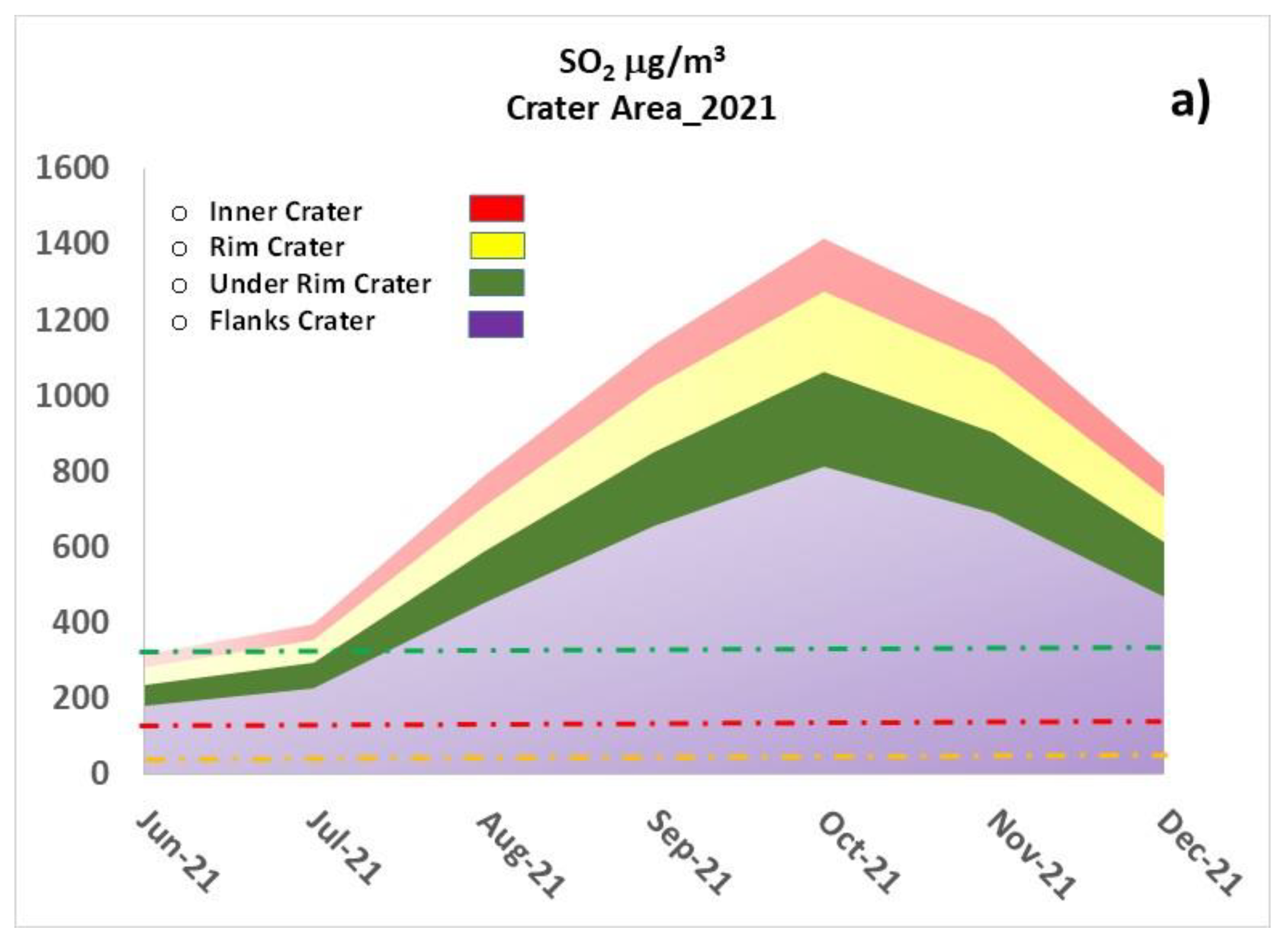


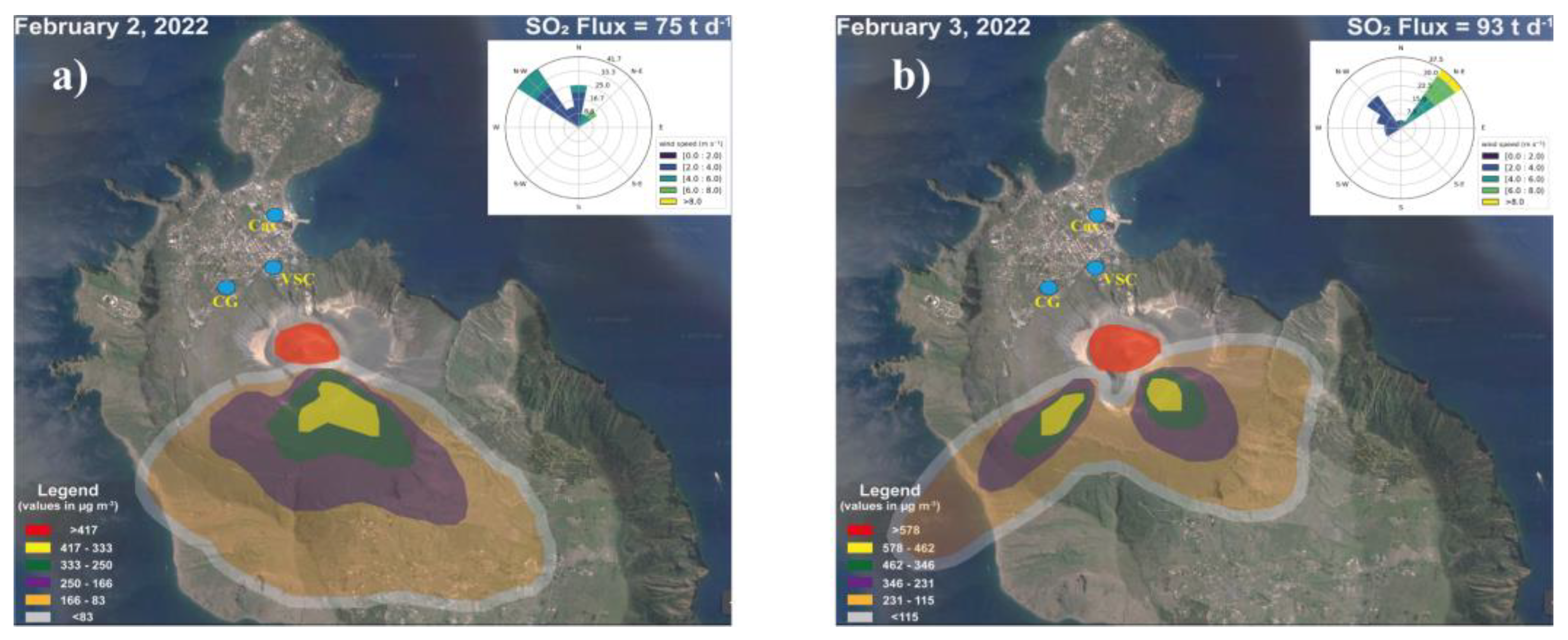


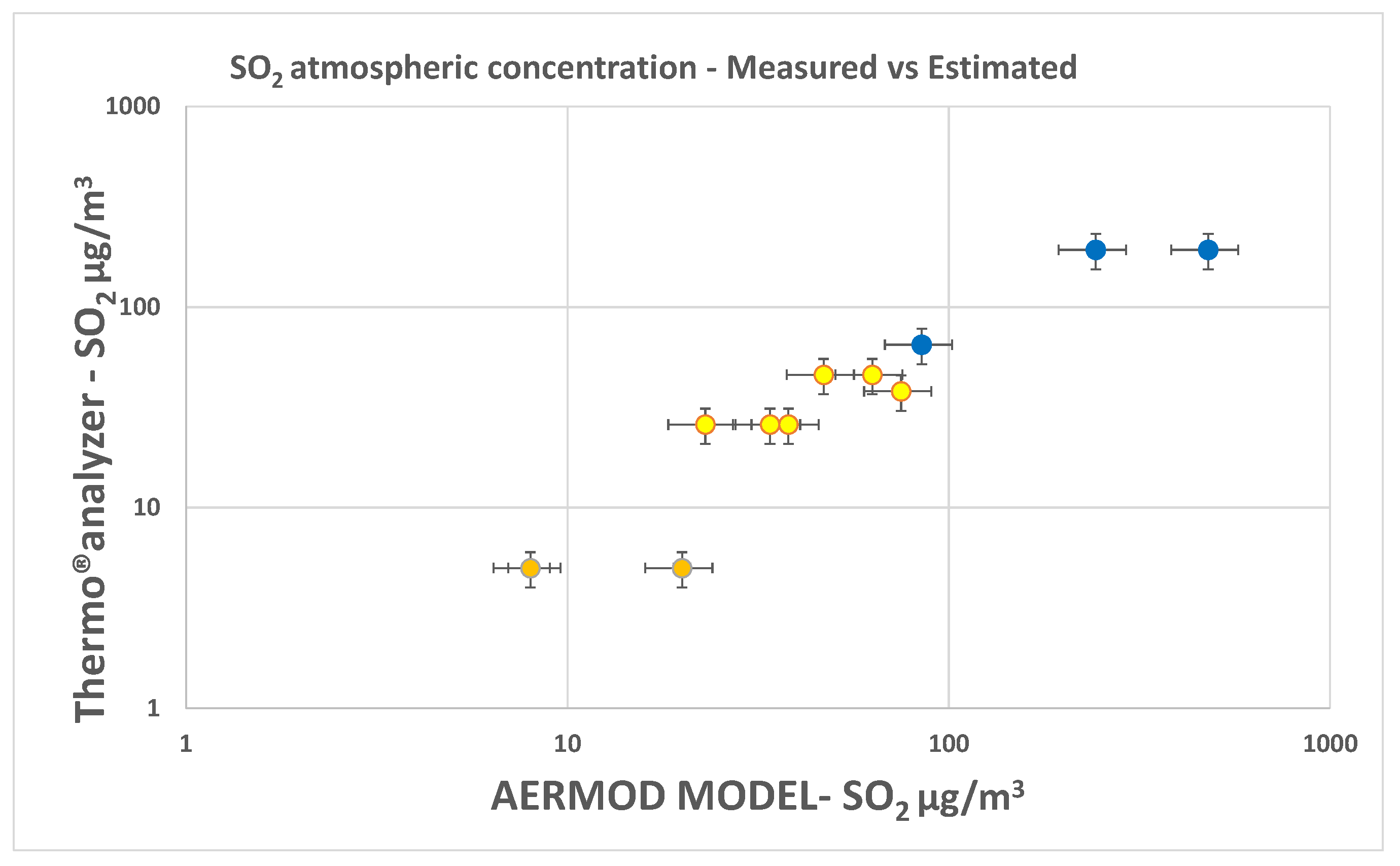
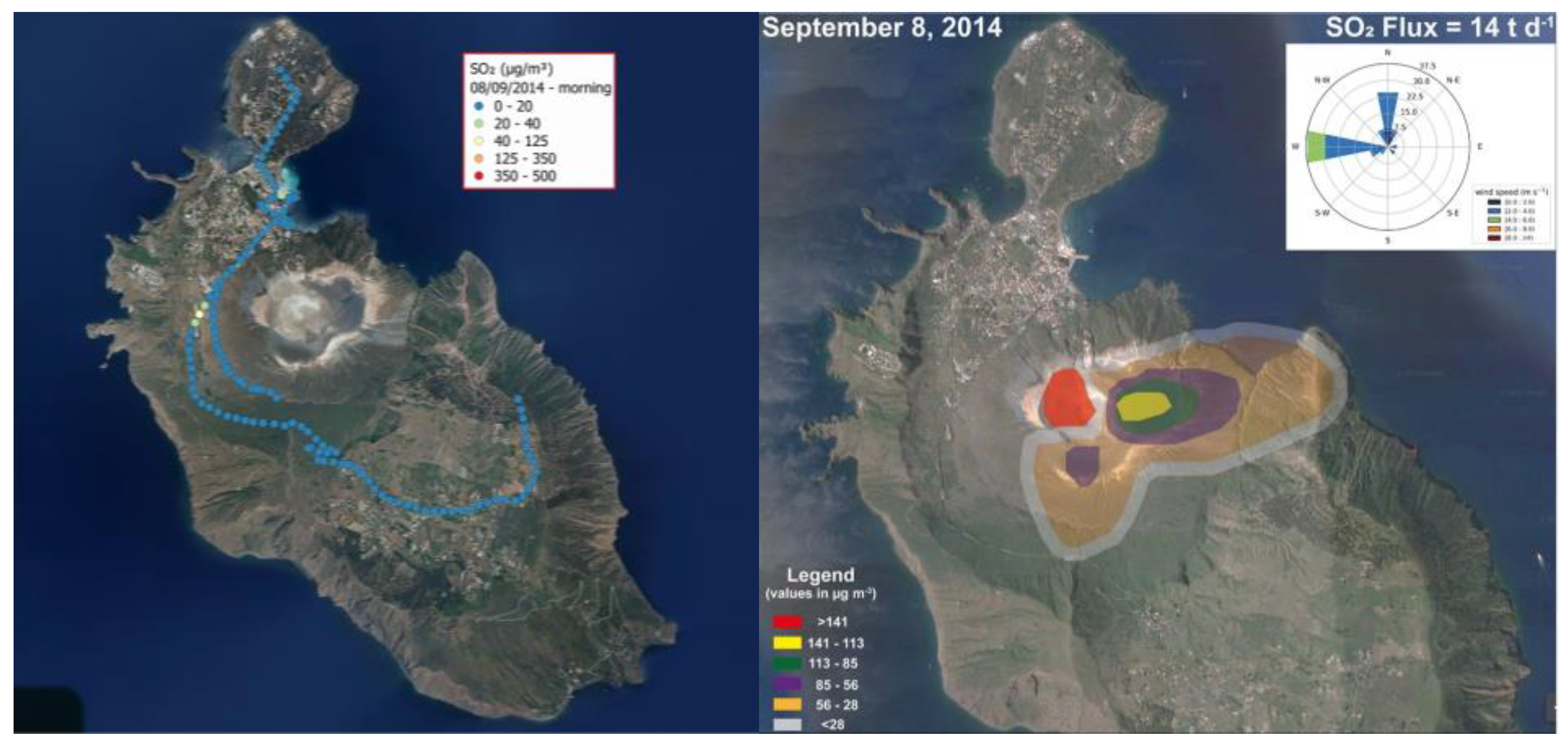

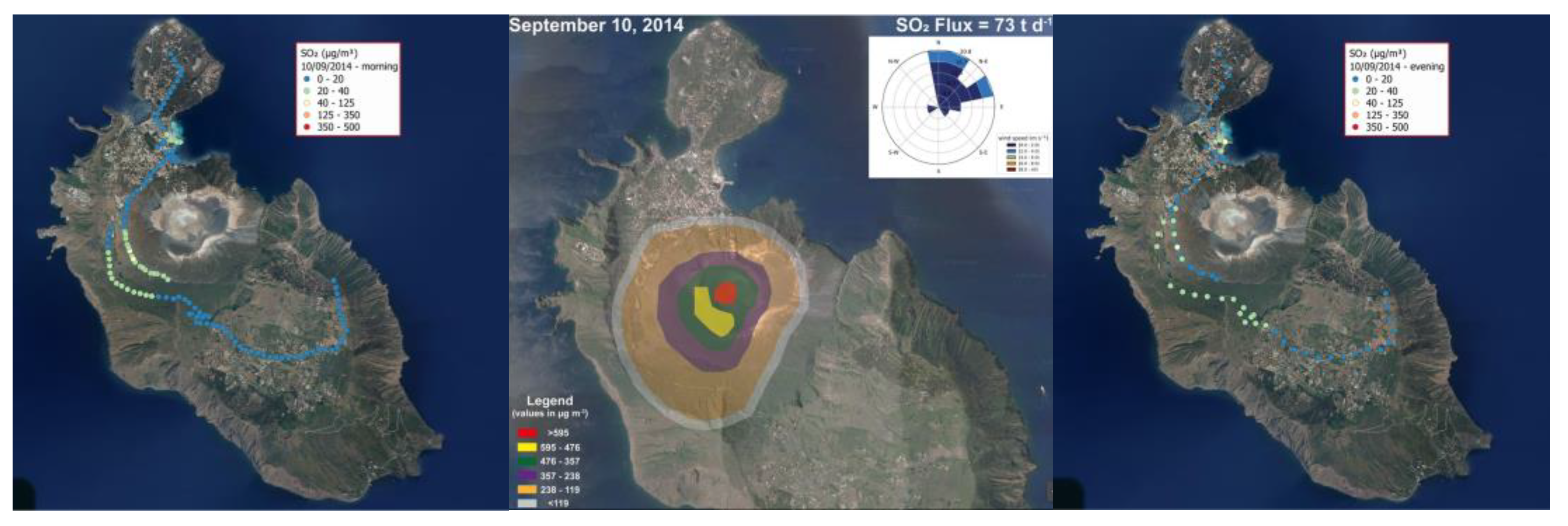
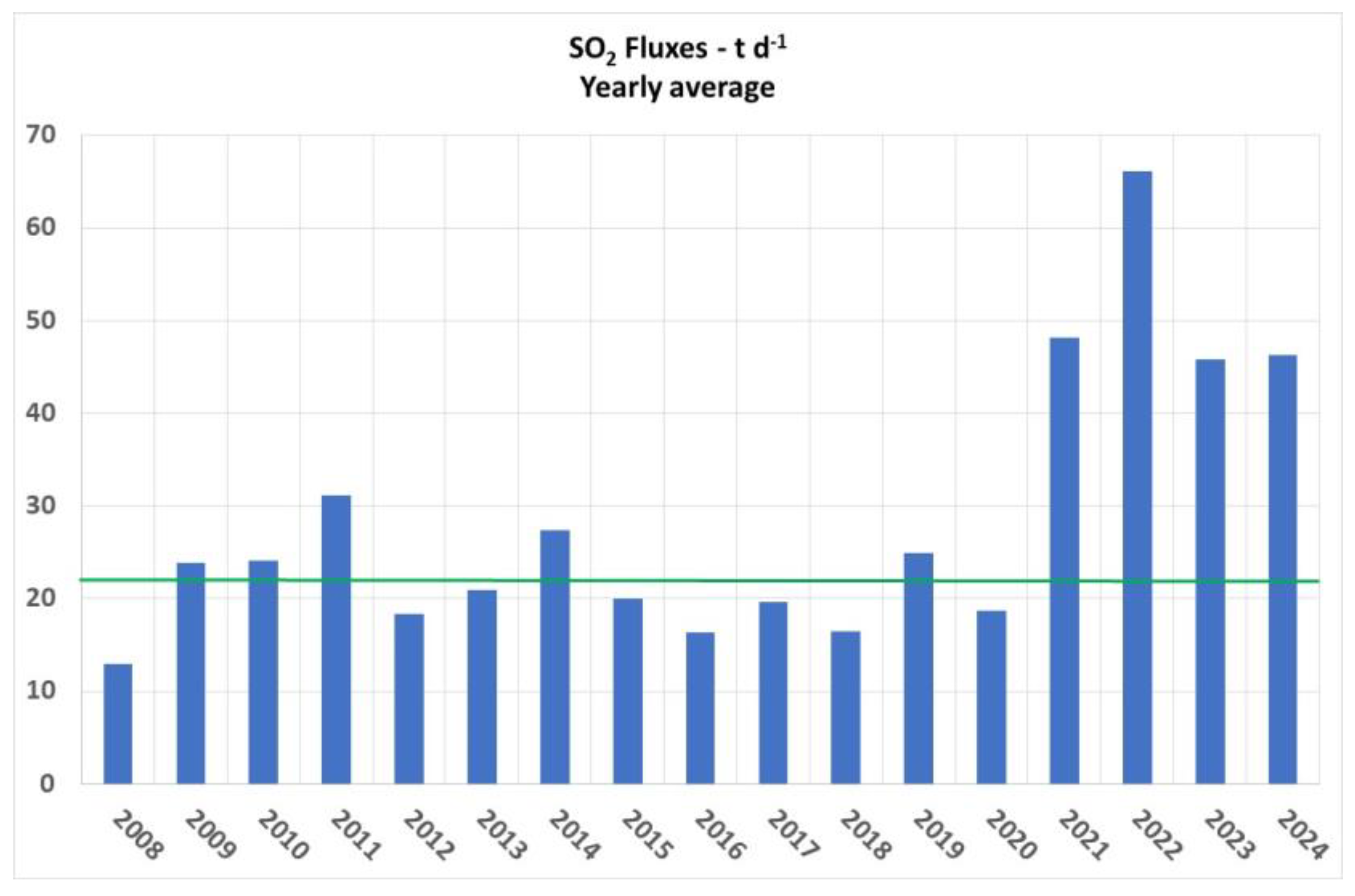
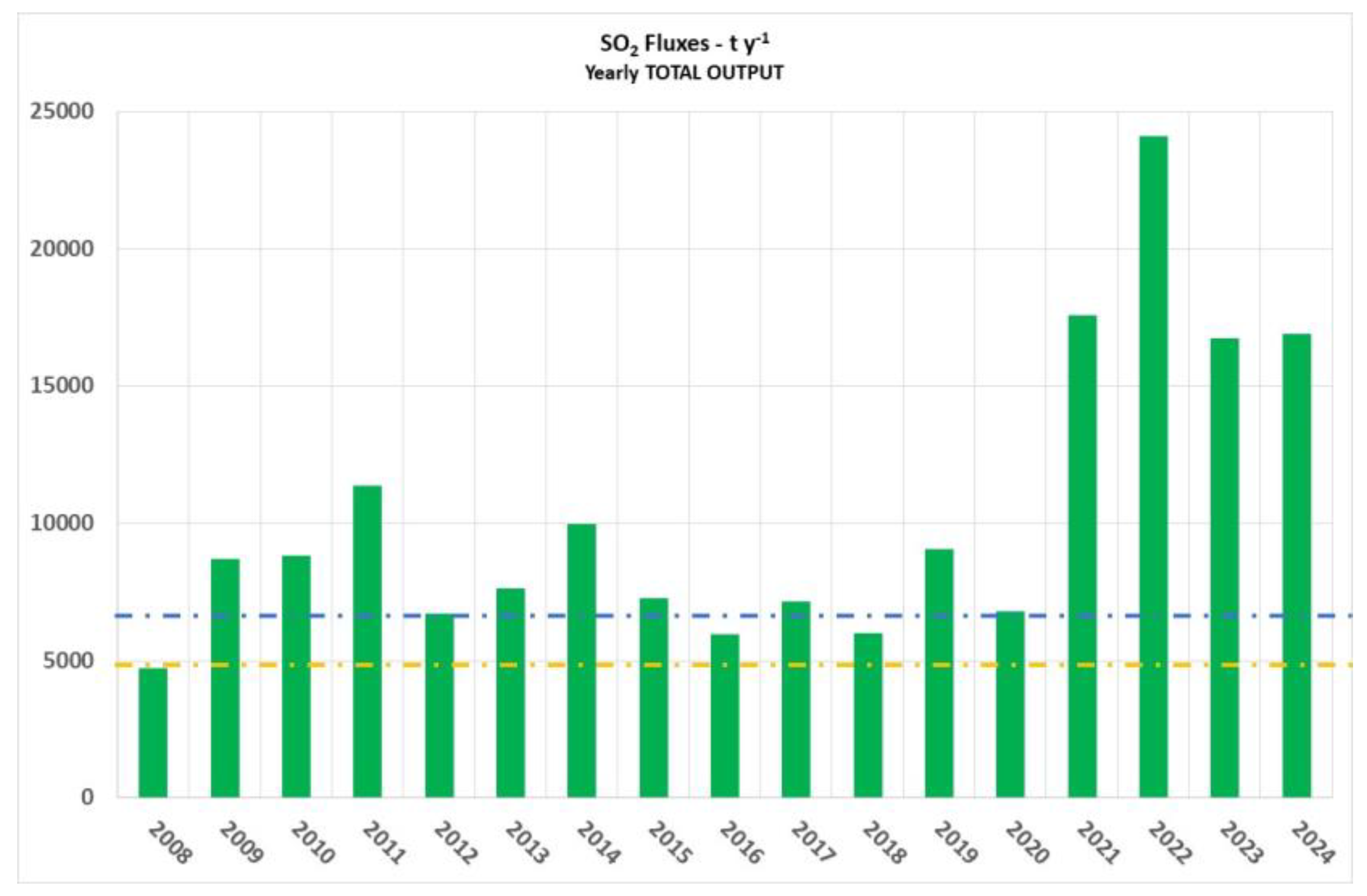
| Year | Site | Zone | E (UTM) | N (UTM) | Start | End | Duration (min) | SO2 (µg/m3) | |||
|---|---|---|---|---|---|---|---|---|---|---|---|
| min | max | mean | std.dev | ||||||||
| 2024 | Il Castello | 33S | 496393 | 4251978 | 2024/6/18 7:45 | 2024/6/18 15:45 | 480 | 24 | 64 | 37.5 | 6.2 |
| 2024/6/20 7:25 | 2024/6/20 15:06 | 461 | 12 | 70.2 | 45.6 | 11 | |||||
| 2024/6/20 16:00 | 2024/6/21 13:07 | 1267 | 11 | 120 | 36.1 | 23.762 | |||||
| 2023 | Il Castello | 33S | 496393 | 4251978 | 2023/6/20 8:49 | 2023/6/22 16:53 | 3364 | 6.4 | 125 | 25.6 | 12 |
| 2022 | Via sotto il cratere | 33S | 496366 | 4251530 | 2022/2/2 10:02 | 2022/2/3 17:40 | 1898 | <5.2 | 5.27 | <5.2 | 0.1 |
| 2021 | Casa Genovese | 33S | 496031 | 4251368 | 2021/11/16 11:15 | 2021/11/16 22:21 | 666 | 6.2 | 5951 | 193 | 474 |
| 2021/11/17 12:20 | 2021/11/18 17:35 | 1755 | <5.2 | 2159 | 65 | 178 | |||||
Disclaimer/Publisher’s Note: The statements, opinions and data contained in all publications are solely those of the individual author(s) and contributor(s) and not of MDPI and/or the editor(s). MDPI and/or the editor(s) disclaim responsibility for any injury to people or property resulting from any ideas, methods, instructions or products referred to in the content. |
© 2025 by the authors. Licensee MDPI, Basel, Switzerland. This article is an open access article distributed under the terms and conditions of the Creative Commons Attribution (CC BY) license (https://creativecommons.org/licenses/by/4.0/).
Share and Cite
Vita, F.; Schiavo, B.; Inguaggiato, C.; Cabassi, J.; Venturi, S.; Tassi, F.; Inguaggiato, S. Output of Volcanic SO2 Gases and Their Dispersion in the Atmosphere: The Case of Vulcano Island, Aeolian Archipelago, Italy. Atmosphere 2025, 16, 651. https://doi.org/10.3390/atmos16060651
Vita F, Schiavo B, Inguaggiato C, Cabassi J, Venturi S, Tassi F, Inguaggiato S. Output of Volcanic SO2 Gases and Their Dispersion in the Atmosphere: The Case of Vulcano Island, Aeolian Archipelago, Italy. Atmosphere. 2025; 16(6):651. https://doi.org/10.3390/atmos16060651
Chicago/Turabian StyleVita, Fabio, Benedetto Schiavo, Claudio Inguaggiato, Jacopo Cabassi, Stefania Venturi, Franco Tassi, and Salvatore Inguaggiato. 2025. "Output of Volcanic SO2 Gases and Their Dispersion in the Atmosphere: The Case of Vulcano Island, Aeolian Archipelago, Italy" Atmosphere 16, no. 6: 651. https://doi.org/10.3390/atmos16060651
APA StyleVita, F., Schiavo, B., Inguaggiato, C., Cabassi, J., Venturi, S., Tassi, F., & Inguaggiato, S. (2025). Output of Volcanic SO2 Gases and Their Dispersion in the Atmosphere: The Case of Vulcano Island, Aeolian Archipelago, Italy. Atmosphere, 16(6), 651. https://doi.org/10.3390/atmos16060651









